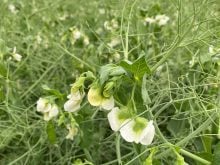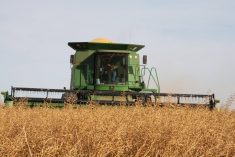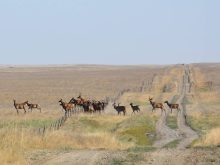THEN: Commercial mustard proves valuable alternative crop for southern Alberta
Few Canadians realize it, but much of the table mustard consumed in Canada is grown in the Dominion. Whether it’s the mild, prepared brand that comes as a paste in bottles or whether it’s the hotter, powdered brand, it’s just as native to the country as most Canadians. That, in spite of the fact that most people associate spices and condiments with far-away foreign lands.
Grown on limited acreages in deep southern Alberta as far back as ten years ago, commercial mustard has enjoyed a great increase in popularity during the past four years. This year approximately 20,000 acres of the crop were grown in the territory from Vulcan south to the international boundary.
Read Also

Crop quality looks good this year across Prairies
Crop quality looks real good this year, with the exception of durum.
NOW:
One factor was Saskatchewan’s closer location to rail lines moving east to processing plants in the United States and to Thunder Bay for export to Europe.
Walter Dyck, seed division manager with Olds Products, a mustard manufacturer, said the shift occurred in the 1960s.
“It caught on in a big way in Alberta after Montana,” he said.
“It just seemed like there were good opportunities for growing it in Canada and it just naturally went to Saskatchewan because of the extent of the dryland farming that is available.”
Acres have varied over the decades. Alberta seeded slightly less than 22,000 acres of the crop in the mid-1970s and more than 90,000 in the mid-1990s, when Saskatchewan’s acreage topped 590,000.
Some 340,000 acres of yellow, brown and oriental mustard were seeded on the Prairies this year.
“Is there growth in the flour industry? In the ground mustard industry? Probably the same comment as condiment (mustard) — slight growth,” said Dyck.
“And that’s really what limits the mustard acres, is that demand that is not significantly increasing.”
More acres have been contracted in Alberta recently, but the split between the provinces remains. Acres are down from five-year averages, but producers contracted to grow the crop can earn more than 40 cents per pound for some varieties and see strong profits.
Production is expected to increase by more than 30 percent this year from last year because of more acres and strong yields. Last year, yields were down to 760 pounds per acre.
“When a producer does a partial budget to put in a crop, mustard has to pencil in with everything else and that is always yield times price,” said Baine Fritzler, chair of Mustard 21 Canada.
“And really, what has kept us in the mustard business here so far is our prices have gone from 25 cents up to 40 and 45 cents in the last three years.”
Mustard 21, a non-profit industry organization affiliated with the Saskatchewan Mustard Development Commission, recently received $5 million in federal funding for research initiatives.
“At one time mustard was the only specialty crop in Alberta (and) Saskatchewan. If you look historically, lentils didn’t exist, and it’s one of the reasons we have to play some catch up,” Fritzler.
With help from Agriculture Canada researchers, the organization is targeting condiment mustard varieties with improved protein and mucilage content and disease resistance. Yield is another focus, along with improved herbicide technology.
“We’re going to do a synthetic hybrid and it’s faster and cheaper than going the full hybrid route,” said Fritzler.
“And if we can get 20 to 25 percent yield increase in yellow (mustard), that’s going to be a pretty big move for us. I don’t think in the last 20 years we’ve moved four percent.”
The organization is also looking to boost production of varieties for burgeoning industrial uses. Officials are looking for improved agronomy and plants with higher oil and protein content, earlier maturing dates and better disease resistance.
“We’re not allowed into the GMO, genetically modified, system in terms of enhancing plants, so it takes more money and it takes a little longer,” said Fritzler.
“Our industry isn’t big enough … to generate enough check-off funds or enough research dollars to do that catching up.”
He said American buyers remain the premiere market for Canadian producers, but competition is appearing in international markets.
“What we have to do is make sure that our quality stays above everybody else’s, and that quality means making good mustard,” said Fritzler.
“So it’s not all about yield.”
















